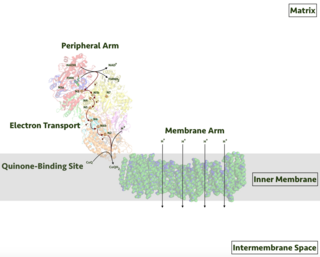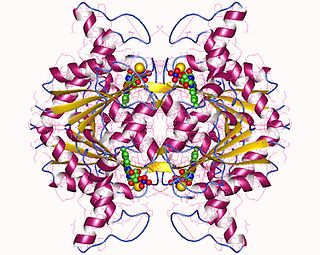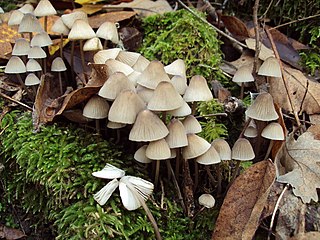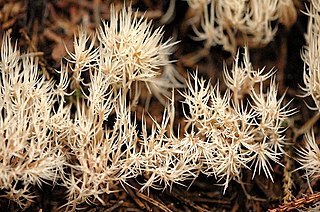
Oxidative phosphorylation or electron transport-linked phosphorylation or terminal oxidation is the metabolic pathway in which cells use enzymes to oxidize nutrients, thereby releasing chemical energy in order to produce adenosine triphosphate (ATP). In eukaryotes, this takes place inside mitochondria. Almost all aerobic organisms carry out oxidative phosphorylation. This pathway is so pervasive because it releases more energy than alternative fermentation processes such as anaerobic glycolysis.

Respiratory complex I, EC 7.1.1.2 is the first large protein complex of the respiratory chains of many organisms from bacteria to humans. It catalyzes the transfer of electrons from NADH to coenzyme Q10 (CoQ10) and translocates protons across the inner mitochondrial membrane in eukaryotes or the plasma membrane of bacteria.

Piericidin A is an antibiotic agent. It was discovered from Streptomyces mobaraensis. Being an inhibitor of NADH dehydrogenase, it inhibits electron transfer; its structure resembles that of the ubiquinone, therefore it competes with QB for binding sites in NADH dehydrogenase as well as Photosystem II.

In enzymology, a NADH dehydrogenase (quinone) (EC 1.6.5.11) is an enzyme that catalyzes the chemical reaction

In enzymology, a NAD(P)H dehydrogenase (quinone) (EC 1.6.5.2) is an enzyme that catalyzes the chemical reaction

MT-ND5 is a gene of the mitochondrial genome coding for the NADH-ubiquinone oxidoreductase chain 5 protein (ND5). The ND5 protein is a subunit of NADH dehydrogenase (ubiquinone), which is located in the mitochondrial inner membrane and is the largest of the five complexes of the electron transport chain. Variations in human MT-ND5 are associated with mitochondrial encephalomyopathy, lactic acidosis, and stroke-like episodes (MELAS) as well as some symptoms of Leigh's syndrome and Leber's hereditary optic neuropathy (LHON).

Mycena galopus, commonly known as the milking bonnet or the milk-drop mycena, is an inedible species of fungus in the family Mycenaceae of the order Agaricales. It produces small mushrooms that have grayish-brown, bell-shaped, radially-grooved caps up to 2.5 cm (1 in) wide. The gills are whitish to gray, widely spaced, and squarely attached to the stem. The slender stems are up to 8 cm (3 in) long, and pale gray at the top, becoming almost black at the hairy base. The stem will ooze a whitish latex if it is injured or broken. The variety nigra has a dark gray cap, while the variety candida is white. All varieties of the mushroom occur during summer and autumn on leaf litter in coniferous and deciduous woodland.

NADH dehydrogenase [ubiquinone] iron-sulfur protein 7, mitochondrial, also knowns as NADH-ubiquinone oxidoreductase 20 kDa subunit, Complex I-20kD (CI-20kD), or PSST subunit is an enzyme that in humans is encoded by the NDUFS7 gene. The NDUFS7 protein is a subunit of NADH dehydrogenase (ubiquinone) also known as Complex I, which is located in the mitochondrial inner membrane and is the largest of the five complexes of the electron transport chain.

NADH dehydrogenase [ubiquinone] 1 beta subcomplex subunit 6, also known as complex I-B17, is a protein that in humans is encoded by the NDUFB6 gene. NADH dehydrogenase (ubiquinone) 1 beta subcomplex subunit 6, is an accessory subunit of the NADH dehydrogenase (ubiquinone) complex, located in the mitochondrial inner membrane. It is also known as Complex I and is the largest of the five complexes of the electron transport chain.

NADH dehydrogenase [ubiquinone] flavoprotein 3, mitochondrial is an enzyme that in humans is encoded by the NDUFV3 gene.

NADH dehydrogenase [ubiquinone] 1 beta subcomplex subunit 9 is an enzyme that in humans is encoded by the NDUFB9 gene. NADH dehydrogenase (ubiquinone) 1 beta subcomplex subunit 9 is an accessory subunit of the NADH dehydrogenase (ubiquinone) complex, located in the mitochondrial inner membrane. It is also known as Complex I and is the largest of the five complexes of the electron transport chain.

NADH dehydrogenase [ubiquinone] 1 alpha subcomplex subunit 8 is an enzyme that in humans is encoded by the NDUFA8 gene. The NDUFA8 protein is a subunit of NADH dehydrogenase (ubiquinone), which is located in the mitochondrial inner membrane and is the largest of the five complexes of the electron transport chain.

NADH dehydrogenase [ubiquinone] 1 alpha subcomplex subunit 10 is an enzyme that in humans is encoded by the NDUFA10 gene. The NDUFA10 protein is a subunit of NADH dehydrogenase (ubiquinone), which is located in the mitochondrial inner membrane and is the largest of the five complexes of the electron transport chain. Mutations in subunits of NADH dehydrogenase (ubiquinone), also known as Complex I, frequently lead to complex neurodegenerative diseases such as Leigh's syndrome. Furthermore, reduced NDUFA10 expression levels due to FOXM1-directed hypermethylation are associated with human squamous cell carcinoma and may be related to other forms of cancer.

NADH dehydrogenase [ubiquinone] 1 beta subcomplex subunit 11, mitochondrial is an enzyme that in humans is encoded by the NDUFB11 gene. NADH dehydrogenase (ubiquinone) 1 beta subcomplex subunit 11 is an accessory subunit of the NADH dehydrogenase (ubiquinone) complex, located in the mitochondrial inner membrane. It is also known as Complex I and is the largest of the five complexes of the electron transport chain. NDUFB11 mutations have been associated with linear skin defects with multiple congenital anomalies 3 and mitochondrial complex I deficiency.

Pterula is a genus of fungi in the Pterulaceae family. The genus has a widespread distribution, especially in tropical regions, and contains about 50 species. One such species, Pterula sp. 82168, has yielded potential antifungal antibiotic properties.
NADH:ubiquinone reductase (Na+-transporting) (EC 1.6.5.8 is an enzyme with systematic name NADH:ubiquinone oxidoreductase (Na+-translocating). In bacteria, three different types of respiratory NADH:quinone oxidoreductases (NQr) have been described: the electrogenic complex I, also called NDH I in bacteria, the non-electrogenic NADH:quinone oxidoreductases (NDH II), and the Na+-translocating NADH:quinone oxidoreductases Na+-NQr. The common function of these transmembrane enzymes in respiration is to oxidize NADH using ubiquinone (Q) as electron acceptor. The net reaction thus yields ubiquinol (QH2), the reducing substrate of enzyme complexes further along the respiratory chain, and NAD+, which is used as oxidizing agent in numerous cellular processes.
NADH:ubiquinone reductase (non-electrogenic) (EC 1.6.5.9, NDH-2, ubiquinone reductase, coenzyme Q reductase, dihydronicotinamide adenine dinucleotide-coenzyme Q reductase, DPNH-coenzyme Q reductase, DPNH-ubiquinone reductase, NADH-coenzyme Q oxidoreductase, NADH-coenzyme Q reductase, NADH-CoQ oxidoreductase, NADH-CoQ reductase) is an enzyme with systematic name NADH:ubiquinone oxidoreductase. This enzyme catalyses the following chemical reaction

NADH dehydrogenase is an enzyme that converts nicotinamide adenine dinucleotide (NAD) from its reduced form (NADH) to its oxidized form (NAD+). Members of the NADH dehydrogenase family and analogues are commonly systematically named using the format NADH:acceptor oxidoreductase. The chemical reaction these enzymes catalyze are generally represented with the follow equation;

NADH:ubiquinone oxidoreductase complex assembly factor 8 is a protein that in humans is encoded by the NDUFAF8 gene. This protein stabilizes NDUFAF5 during assembly of mitochondrial Complex I.

Aureothin is a natural product of a cytotoxic shikimate-polyketide antibiotic with the molecular formula C22H23NO6. Aureothin is produced by the bacterium Streptomyces thioluteus that illustrates antitumor, antifungal, and insecticidal activities and the new aureothin derivatives can be antifungal and antiproliferative. In addition, aureothin, a nitro compound from Streptomyces thioluteus, was indicated to have pesticidal activity against the bean weevil by interfering with mitochondrial respiratory complex II.

















